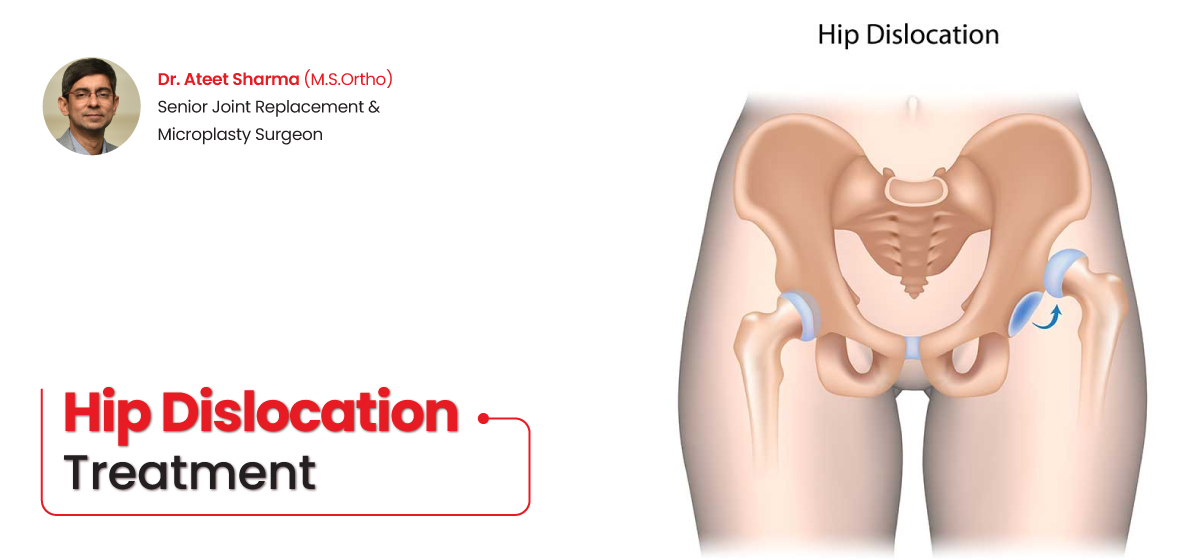
Hip dislocation is a severe medical problem that necessitates quick attention and treatment. Trauma, injury, or previous diseases can all contribute to it. It is one of the most common joint ailments, causing considerable pain and movement restrictions if not treated efficiently. Although conventional treatments work well, robotic hip replacement has changed the dynamics of treating chronic and severe hip dislocations. If you are going through the same problem, you can visit Dr Ateet Sharma for the Best Robotic Hip Replacement Treatment in Ahmedabad.
In this blog, we will discuss the various techniques for Hip Dislocation Treatment.

A hip dislocation is when the ball of the femur (thigh bone) is pushed out from its socket in the pelvis. This is usually after a car accident, playing sports, or it occurs secondary to previous surgeries, etc. This condition is very extremely painful, causing immobilization and the possibility of irreversible damage if not treated promptly. Surgery also may be the best long-term solution for people who have recurrent dislocations or suffer from a degenerative condition, such as osteoarthritis.
Orthopaedic care traditionally focuses on reducing and preventing joint dislocation. These include :
1. Closed Reduction : When the hip has dislocated without an associated fracture, and doctors push this back into place (whilst under sedation or anaesthetic). This particular method may work for a temporary duration, but patients with a weak hip joint can dislocate over and over again.
2. Open Reduction Surgery : If there is a fracture or another type of damage to the hip, open surgery may be required. It means fixing the bone and soft tissue, including ligaments and cartilage.
3. Physical Therapy : Once the hip is relocated, rehabilitation to restore range of motion and strength is extremely important. But, when it comes to extreme dislocations or repeated problems, the old ways could lead to more of that same problem in the future.
Although traditional Hip Dislocation Treatments have their time and place, robotic hip replacement takes a new approach that promises more accurate, long-term results. Robotic hip replacement could be the most comprehensive, permanent fix for those who have had multiple hip dislocations or degenerative hip ailments.
Many get second thoughts on Anterior vs. traditional Hip Replacement. Treatment for persistent hip dislocations or unstable hips is best served by robotic hip replacement. Here's why.
1. Increased Protection for the Long Term : Alignment issues of the hip joint are one core cause associated with repeat dislocations. Robotic Hip Dislocation Treatment increases the accuracy and alignment of hip implants, reducing the chance of dislocation in the future.
2. Best for Complicated Cases : Robotic Hip Dislocation Treatment has that high level of precision that a robotic arm brings to the table, and due to this, it may be your best choice for multiple dislocations, damaged cartilage, and ligaments, where a conventional surgery may not reach or help it as accurately due to complex damage.
3. Faster Recovery Times : Many patients who have robotic hip replacement surgery report less pain and shorter recovery time. Because the surgery is relatively simple and accomplished with pinpoint precision, there is less surrounding tissue damage compared to traditional surgery, so patients can resume daily activities sooner.
What is the recovery time for robotic hip joint replacement? While the recovery time will vary from person to person, based on age and general health condition, many patients who undergo successful robotic hip joint replacement surgeries start seeing noticeable improvements as soon as a few weeks. One more important thing to remember is that restoration usually starts the next or second day post-operation and gradually works towards regaining motion and power.
Those who choose robotic Hip dislocation treatment see the following benefits :
Go Through Lesser Pain : Smaller incisions and greater surgical precision result in less discomfort for patients when compared to standard hip replacement procedures.
Faster Activity Resumption : Many patients resume daily activities such as walking and light exercise in less than a week, compared to those who had conventional surgery.
Rehabilitation will be tailored to you and organised by your surgeon and physical therapist. This program is designed to help you regain your hip movement ability and rehab you closer, where you can build your fitness.
If you have a history of severe or recurrent hip dislocation, and your hip joint is weakened by arthritis or injury, Robotic Hip Dislocation Treatment might be an optimal solution. Benefits of this procedure include more precise results, superior alignment, and shorter recovery times than standard methods. Speaking with your orthopedic surgeon may help you to decide if robotic hip replacement is right for you.
Hip dislocation used to be a devastating condition, but with the advancements in the medical field, there has been no shortage of treatment options. Particularly, robotic hip replacement has changed the way we approach hip surgery and offers patients a more accurate, successful, and durable treatment for their hip.
If chronic hip dislocations are a problem for you or your loved one, it may be time to check out this new technique. Visit Dr Ateet Sharma for a Robotic Hip Dislocation Treatment that helps prevent your hip from dislocating again and markedly enhances the way you live.
© 2025 Dr.Ateet Sharma All rights reserved. | Manage by Nexus